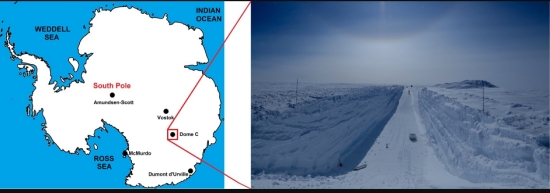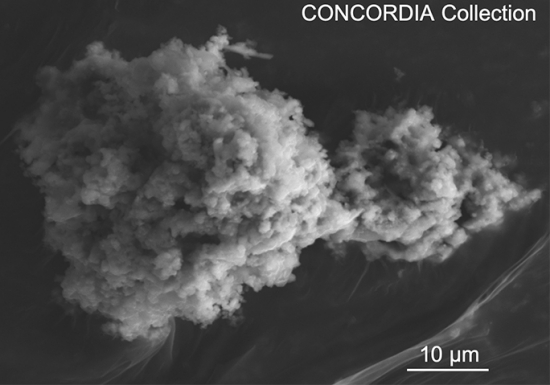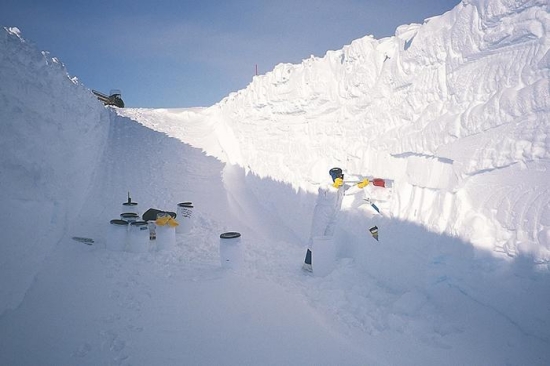Interesting news out of CNRS (the French National Center for Scientific Research) renews our attention to the mechanisms for supplying the early Earth with water and carbonaceous molecules. We’ve looked at comets as possible water sources for a world forming well inside the snow line, and asteroids as well. What the CNRS work reminds us is that micrometeorites also play a role. In fact, according to the paper just out in Earth and Planetary Science Letters, 5,200 tons of extraterrestrial materials — dust particles from space — reach the ground yearly.

Image: From the paper’s Figure 1, although not the complete figure. The relevant part of the caption: Fig. 1. Left: Location of the CONCORDIA station (Dome C, Antarctica). Centre: View of a trench at Dome C. Credit: Rojas et al.
This conclusion comes from a study spanning almost twenty years, conducted by scientists in an international collaboration involving laboratories in France, the United States and the United Kingdom. CNRS researcher Jean Duprat has led six expeditions during this time span to the Franco-Italian Concordia station (Dome C), 1100 kilometers from the coast in the Antarctic territory Terre Adélie, which is claimed by France. France’s permanent outpost in Terre Adélie is Dumont d’Urville Station. The Dome C area is considered ideal for the study of micrometeorites because of the near absence of terrestrial dust and low rates of accumulation of snow.

Image: Electron micrograph of a Concordia micrometeorite extracted from Antarctic snow at Dome. Credit: © Cécile Engrand/Jean Duprat.
The dust particles collected by these expeditions have ranged from 30 to 200 micrometers (µm) in size, and enough have been gathered to calculate the mass accreted to Earth per square meter per year, the aforementioned 5,200 tons. This would make micrometeorites the primary source of extraterrestrial matter on our planet — the flux from meteorites is measured as less than 10 tons per year.
The paper explains what happens as micrometeorites encounter the Earth’s atmosphere:
The degree of heating experienced by the particles during their atmospheric entry depends on various factors including the initial mass of the particles, their entry angle and velocity. The ablated metallic vapours oxidize and the resulting metal oxides, hydroxides and carbonates condense into nm-sized particles termed meteoric smoke (Plane et al., 2015). These particles are transported by the general atmospheric circulation until eventually deposited at the surface, where their flux can be evaluated by elemental or isotopic measurements (Gabrielli et al. (2004).
The size distribution of extraterrestrial particles before entry into the atmosphere was studied by measuring the craters that high velocity sub-millimetre grain collisions produced on the Long Duration Exposure Facility satellite (LDEF) panel. This was an interesting mission. The LDEF spent over five years orbiting the Earth to measure the effects of micrometeoroids, space debris, radiation particles, atomic oxygen, and solar radiation on spacecraft materials, components, and systems before being retrieved in 1990 by the Space Shuttle STS-32 mission.

Image: Collecting micrometeorites in the central Antarctic regions, at Dome C in 2002. Snow sampling. Credit: © Jean Duprat/ Cécile Engrand/ CNRS Photothèque.
The paper is Rojas et al., “The micrometeorite flux at Dome C (Antarctica), monitoring the accretion of extraterrestrial dust on Earth,” Earth and Planetary Science Letters Volume 560 (15 April 2021) 116794 (full text).



This month’s BBC Sky At Night includes some examples of meteorites as well as finding the meteorite that recently fell over England. An earlier episode interviewed a researcher who collected meteorite particles off the roof of the facility he worked at. I can’t recall how he distinguished meteorite particles from terrestrial ones.
The mass ratio of 5200:10 of micrometeoroids: meteorites indicates that the ratio of the numbers of particles is orders of magnitude higher. Old Sci-Fi movies always showed huge meteors, often in streams, as the main danger to spaceships, although micrometeoroid punctures must be by far the most problematic, especially if the ship was not protected by Whipple Shields. Such is Hollywood. It might be interesting to inspect the Apollo LM descent stages to see how much damage such micrometeoroids can make on such flimsy structures.
As we launch comsat swarms the probability of damaging or crippling a satellite must increase, possibly adding to the potential of starting a Kessler syndrome. We are going to need to seriously address the cleanup and removal of dead satellites and debris. We don’t want to be trapped on Earth, just as we have the technology to leave it.
Interesting topic and with some curiosity for me. Can the cosmic dust form nucleation sites for high altitude clouds?
Would the particle undergo melting/vaporization per the article? IIRC, a calculation was made that a sheet of paper (perhaps folded like a paper airplane) could reenter Earth’s atmosphere at orbital velocity and survive. It is a matter of mechanical strength, thermal radiating areas, and the ratio of mass to frontal area. A micron-sized particle could possibly decelerate quickly enough before there would be sufficient radiative heat transfer from the plasma shock wave to do much to the particle. The internet has a discussion on this topic ranging from simplistic to thoughtful.